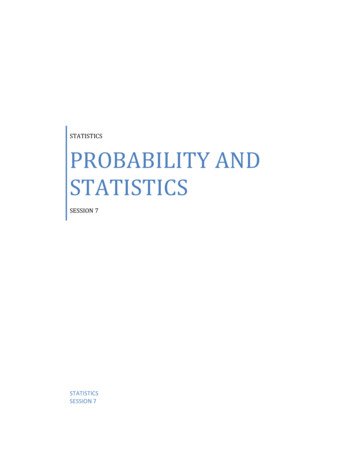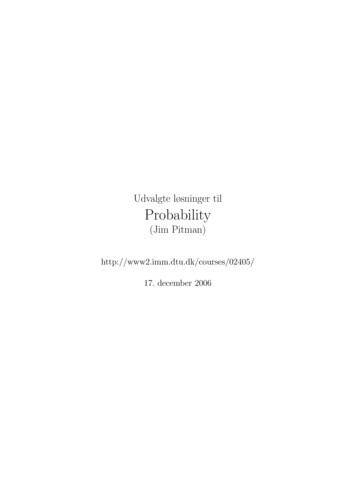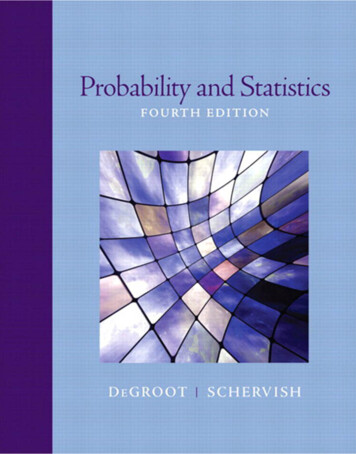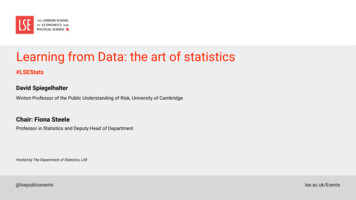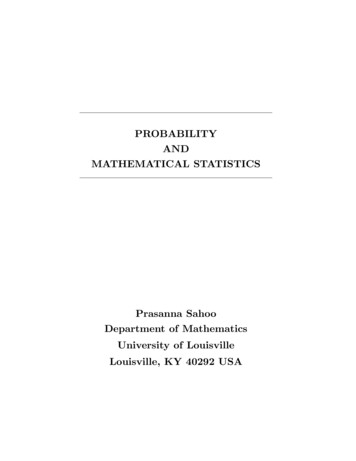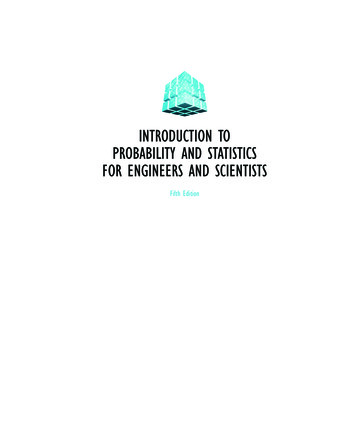
Transcription
PROBABILITYAND STATISTICSFOR ECONOMISTSBRUCE E. HANSEN
ContentsPrefacexAcknowledgementsxiMathematical PreparationxiiNotation12xiiiBasic Probability Theory1.1Introduction . . . . . . . . . . . . . . . . .1.2Outcomes and Events . . . . . . . . . . . .1.3Probability Function . . . . . . . . . . . .1.4Properties of the Probability Function . .1.5Equally-Likely Outcomes . . . . . . . . . .1.6Joint Events . . . . . . . . . . . . . . . . . .1.7Conditional Probability . . . . . . . . . . .1.8Independence . . . . . . . . . . . . . . . .1.9Law of Total Probability . . . . . . . . . . .1.10 Bayes Rule . . . . . . . . . . . . . . . . . .1.11 Permutations and Combinations . . . . .1.12 Sampling With and Without Replacement1.13 Poker Hands . . . . . . . . . . . . . . . . .1.14 Sigma Fields* . . . . . . . . . . . . . . . . .1.15 Technical Proofs* . . . . . . . . . . . . . .1.16 Exercises . . . . . . . . . . . . . . . . . . .111345567910111314161718Random Variables2.1Introduction . . . . . . . . . . . . . . . . . . . . . . .2.2Random Variables . . . . . . . . . . . . . . . . . . . .2.3Discrete Random Variables . . . . . . . . . . . . . . .2.4Transformations . . . . . . . . . . . . . . . . . . . . .2.5Expectation . . . . . . . . . . . . . . . . . . . . . . . .2.6Finiteness of Expectations . . . . . . . . . . . . . . .2.7Distribution Function . . . . . . . . . . . . . . . . . .2.8Continuous Random Variables . . . . . . . . . . . .2.9Quantiles . . . . . . . . . . . . . . . . . . . . . . . . .2.10 Density Functions . . . . . . . . . . . . . . . . . . . .2.11 Transformations of Continuous Random Variables2.12 Non-Monotonic Transformations . . . . . . . . . . .22222222242526282931313436ii.
232.242.252.262.2734iiiExpectation of Continuous Random VariablesFiniteness of Expectations . . . . . . . . . . . .Unifying Notation . . . . . . . . . . . . . . . . .Mean and Variance . . . . . . . . . . . . . . . .Moments . . . . . . . . . . . . . . . . . . . . . .Jensen’s Inequality . . . . . . . . . . . . . . . . .Applications of Jensen’s Inequality* . . . . . . .Symmetric Distributions . . . . . . . . . . . . .Truncated Distributions . . . . . . . . . . . . .Censored Distributions . . . . . . . . . . . . . .Moment Generating Function . . . . . . . . . .Cumulants . . . . . . . . . . . . . . . . . . . . .Characteristic Function . . . . . . . . . . . . . .Expectation: Mathematical Details* . . . . . .Exercises . . . . . . . . . . . . . . . . . . . . . 59606061616262636364646565666667687071Multivariate Distributions4.1Introduction . . . . . . . . . . . . . . . . . . . . . . . . . . . . . . . . . . . . . . . . . . . . .4.2Bivariate Random Variables . . . . . . . . . . . . . . . . . . . . . . . . . . . . . . . . . . . .747475Parametric Distributions3.1Introduction . . . . . . . . . . . . . . .3.2Bernoulli Distribution . . . . . . . . . .3.3Rademacher Distribution . . . . . . .3.4Binomial Distribution . . . . . . . . . .3.5Multinomial Distribution . . . . . . . .3.6Poisson Distribution . . . . . . . . . .3.7Negative Binomial Distribution . . . .3.8Uniform Distribution . . . . . . . . . .3.9Exponential Distribution . . . . . . . .3.10 Double Exponential Distribution . . .3.11 Generalized Exponential Distribution3.12 Normal Distribution . . . . . . . . . . .3.13 Cauchy Distribution . . . . . . . . . . .3.14 Student t Distribution . . . . . . . . . .3.15 Logistic Distribution . . . . . . . . . .3.16 Chi-Square Distribution . . . . . . . .3.17 Gamma Distribution . . . . . . . . . .3.18 F Distribution . . . . . . . . . . . . . .3.19 Non-Central Chi-Square . . . . . . . .3.20 Beta Distribution . . . . . . . . . . . .3.21 Pareto Distribution . . . . . . . . . . .3.22 Lognormal Distribution . . . . . . . .3.23 Weibull Distribution . . . . . . . . . . .3.24 Extreme Value Distribution . . . . . .3.25 Mixtures of Normals . . . . . . . . . . .3.26 Technical Proofs* . . . . . . . . . . . .3.27 Exercises . . . . . . . . . . . . . . . . .
756ivBivariate Distribution Functions . . . . . . . . . . . . . . . .Probability Mass Function . . . . . . . . . . . . . . . . . . . .Probability Density Function . . . . . . . . . . . . . . . . . .Marginal Distribution . . . . . . . . . . . . . . . . . . . . . . .Bivariate Expectation . . . . . . . . . . . . . . . . . . . . . . .Conditional Distribution for Discrete X . . . . . . . . . . . .Conditional Distribution for Continuous X . . . . . . . . . .Visualizing Conditional Densities . . . . . . . . . . . . . . . .Independence . . . . . . . . . . . . . . . . . . . . . . . . . . .Covariance and Correlation . . . . . . . . . . . . . . . . . . .Cauchy-Schwarz . . . . . . . . . . . . . . . . . . . . . . . . . .Conditional Expectation . . . . . . . . . . . . . . . . . . . . .Law of Iterated Expectations . . . . . . . . . . . . . . . . . . .Conditional Variance . . . . . . . . . . . . . . . . . . . . . . .Hölder’s and Minkowski’s Inequalities* . . . . . . . . . . . .Vector Notation . . . . . . . . . . . . . . . . . . . . . . . . . .Triangle Inequalities* . . . . . . . . . . . . . . . . . . . . . . .Multivariate Random Vectors . . . . . . . . . . . . . . . . . .Pairs of Multivariate Vectors . . . . . . . . . . . . . . . . . . .Multivariate Transformations . . . . . . . . . . . . . . . . . .Convolutions . . . . . . . . . . . . . . . . . . . . . . . . . . . .Hierarchical Distributions . . . . . . . . . . . . . . . . . . . .Existence and Uniqueness of the Conditional Expectation* .Identification . . . . . . . . . . . . . . . . . . . . . . . . . . . .Exercises . . . . . . . . . . . . . . . . . . . . . . . . . . . . . .Normal and Related Distributions5.1Introduction . . . . . . . . . . . . . . . . . . . .5.2Univariate Normal . . . . . . . . . . . . . . . . .5.3Moments of the Normal Distribution . . . . . .5.4Normal Cumulants . . . . . . . . . . . . . . . .5.5Normal Quantiles . . . . . . . . . . . . . . . . .5.6Truncated and Censored Normal Distributions5.7Multivariate Normal . . . . . . . . . . . . . . . .5.8Properties of the Multivariate Normal . . . . .5.9Chi-Square, t, F, and Cauchy Distributions . . .5.10 Hermite Polynomials* . . . . . . . . . . . . . . .5.11 Technical Proofs* . . . . . . . . . . . . . . . . .5.12 Exercises . . . . . . . . . . . . . . . . . . . . . .Sampling6.1Introduction . . . . . . . . . . . . .6.2Samples . . . . . . . . . . . . . . . .6.3Empirical Illustration . . . . . . . .6.4Statistics, Parameters, Estimators .6.5Sample Mean . . . . . . . . . . . . .6.6Expected Value of Transformations6.7Functions of Parameters . . . . . 6.128128128130130132133133.
6.196.206.216.226.2378Sampling Distribution . . . . . . .Estimation Bias . . . . . . . . . . .Estimation Variance . . . . . . . . .Mean Squared Error . . . . . . . . .Best Unbiased Estimator . . . . . .Estimation of Variance . . . . . . .Standard Error . . . . . . . . . . . .Multivariate Means . . . . . . . . .Order Statistics . . . . . . . . . . .Higher Moments of Sample Mean*Normal Sampling Model . . . . . .Normal Residuals . . . . . . . . . .Normal Variance Estimation . . . .Studentized Ratio . . . . . . . . . .Multivariate Normal Sampling . . .Exercises . . . . . . . . . . . . . . .v.Law of Large Numbers7.1Introduction . . . . . . . . . . . . . . . . . . . .7.2Asymptotic Limits . . . . . . . . . . . . . . . . .7.3Convergence in Probability . . . . . . . . . . .7.4Chebyshev’s Inequality . . . . . . . . . . . . . .7.5Weak Law of Large Numbers . . . . . . . . . . .7.6Counter-Examples . . . . . . . . . . . . . . . . .7.7Examples . . . . . . . . . . . . . . . . . . . . . .7.8Illustrating Chebyshev’s . . . . . . . . . . . . .7.9Vector-Valued Moments . . . . . . . . . . . . .7.10 Continuous Mapping Theorem . . . . . . . . .7.11 Examples . . . . . . . . . . . . . . . . . . . . . .7.12 Uniformity Over Distributions* . . . . . . . . .7.13 Almost Sure Convergence and the Strong Law*7.14 Technical Proofs* . . . . . . . . . . . . . . . . .7.15 Exercises . . . . . . . . . . . . . . . . . . . . . ntral Limit Theory8.1Introduction . . . . . . . . . . . . . . . . . . . . . .8.2Convergence in Distribution . . . . . . . . . . . . .8.3Sample Mean . . . . . . . . . . . . . . . . . . . . . .8.4A Moment Investigation . . . . . . . . . . . . . . .8.5Convergence of the Moment Generating Function8.6Central Limit Theorem . . . . . . . . . . . . . . . .8.7Applying the Central Limit Theorem . . . . . . . .8.8Multivariate Central Limit Theorem . . . . . . . .8.9Delta Method . . . . . . . . . . . . . . . . . . . . . .8.10 Examples . . . . . . . . . . . . . . . . . . . . . . . .8.11 Asymptotic Distribution for Plug-In Estimator . .8.12 Covariance Matrix Estimation . . . . . . . . . . . .8.13 t-ratios . . . . . . . . . . . . . . . . . . . . . . . . . .165165165166166167168169170170171172172173.
CONTENTS8.148.158.169viStochastic Order Symbols . . . . . . . . . . . . . . . . . . . . . . . . . . . . . . . . . . . . . 173Technical Proofs* . . . . . . . . . . . . . . . . . . . . . . . . . . . . . . . . . . . . . . . . . . 175Exercises . . . . . . . . . . . . . . . . . . . . . . . . . . . . . . . . . . . . . . . . . . . . . . . 176Advanced Asymptotic Theory*9.1Introduction . . . . . . . . . . . . . . . . . . . . . . .9.2Heterogeneous Central Limit Theory . . . . . . . . .9.3Multivariate Heterogeneous CLTs . . . . . . . . . . .9.4Uniform CLT . . . . . . . . . . . . . . . . . . . . . . .9.5Uniform Integrability . . . . . . . . . . . . . . . . . .9.6Uniform Stochastic Bounds . . . . . . . . . . . . . .9.7Convergence of Moments . . . . . . . . . . . . . . .9.8Edgeworth Expansion for the Sample Mean . . . . .9.9Edgeworth Expansion for Smooth Function Model9.10 Cornish-Fisher Expansions . . . . . . . . . . . . . . .9.11 Technical Proofs . . . . . . . . . . . . . . . . . . . . .17917917918118118218318318418518718810 Maximum Likelihood Estimation10.1 Introduction . . . . . . . . . . . . . . . . . . . . . .10.2 Parametric Model . . . . . . . . . . . . . . . . . . .10.3 Likelihood . . . . . . . . . . . . . . . . . . . . . . .10.4 Likelihood Analog Principle . . . . . . . . . . . . .10.5 Invariance Property . . . . . . . . . . . . . . . . . .10.6 Examples . . . . . . . . . . . . . . . . . . . . . . . .10.7 Score, Hessian, and Information . . . . . . . . . .10.8 Examples . . . . . . . . . . . . . . . . . . . . . . . .10.9 Cramér-Rao Lower Bound . . . . . . . . . . . . . .10.10 Examples . . . . . . . . . . . . . . . . . . . . . . . .10.11 Cramér-Rao Bound for Functions of Parameters .10.12 Consistent Estimation . . . . . . . . . . . . . . . .10.13 Asymptotic Normality . . . . . . . . . . . . . . . . .10.14 Asymptotic Cramér-Rao Efficiency . . . . . . . . .10.15 Variance Estimation . . . . . . . . . . . . . . . . . .10.16 Kullback-Leibler Divergence . . . . . . . . . . . . .10.17 Approximating Models . . . . . . . . . . . . . . . .10.18 Distribution of the MLE under Mis-Specification .10.19 Variance Estimation under Mis-Specification . . .10.20 Technical Proofs* . . . . . . . . . . . . . . . . . . .10.21 Exercises . . . . . . . . . . . . . . . . . . . . . . . 1321421521621722111 Method of Moments11.1 Introduction . . . . . . . .11.2 Multivariate Means . . . .11.3 Moments . . . . . . . . . .11.4 Smooth Functions . . . . .11.5 Central Moments . . . . .11.6 Best Unbiased Estimation11.7 Parametric Models . . . . .225225225226227230231233.
6Examples of Parametric Models . . . . . . . . . .Moment Equations . . . . . . . . . . . . . . . . .Asymptotic Distribution for Moment EquationsExample: Euler Equation . . . . . . . . . . . . . .Empirical Distribution Function . . . . . . . . .Sample Quantiles . . . . . . . . . . . . . . . . . .Robust Variance Estimation . . . . . . . . . . . .Technical Proofs* . . . . . . . . . . . . . . . . . .Exercises . . . . . . . . . . . . . . . . . . . . . . .vii.12 Numerical Optimization12.1 Introduction . . . . . . . . . . . . . . . . . . . . . . .12.2 Numerical Function Evaluation and Differentiation12.3 Root Finding . . . . . . . . . . . . . . . . . . . . . . .12.4 Minimization in One Dimension . . . . . . . . . . .12.5 Failures of Minimization . . . . . . . . . . . . . . . .12.6 Minimization in Multiple Dimensions . . . . . . . .12.7 Constrained Optimization . . . . . . . . . . . . . . .12.8 Nested Minimization . . . . . . . . . . . . . . . . . .12.9 Tips and Tricks . . . . . . . . . . . . . . . . . . . . . .12.10 Exercises . . . . . . . . . . . . . . . . . . . . . . . . .13 Hypothesis Testing13.1 Introduction . . . . . . . . . . . . . . . . . . . . . . . .13.2 Hypotheses . . . . . . . . . . . . . . . . . . . . . . . . .13.3 Acceptance and Rejection . . . . . . . . . . . . . . . .13.4 Type I and II Error . . . . . . . . . . . . . . . . . . . . .13.5 One-Sided Tests . . . . . . . . . . . . . . . . . . . . . .13.6 Two-Sided Tests . . . . . . . . . . . . . . . . . . . . . .13.7 What Does “Accept H0 ” Mean About H0 ? . . . . . . . .13.8 t Test with Normal Sampling . . . . . . . . . . . . . . .13.9 Asymptotic t-test . . . . . . . . . . . . . . . . . . . . . .13.10 Likelihood Ratio Test for Simple Hypotheses . . . . .13.11 Neyman-Pearson Lemma . . . . . . . . . . . . . . . .13.12 Likelihood Ratio Test Against Composite Alternatives13.13 Likelihood Ratio and t tests . . . . . . . . . . . . . . .13.14 Statistical Significance . . . . . . . . . . . . . . . . . .13.15 P-Value . . . . . . . . . . . . . . . . . . . . . . . . . . .13.16 Composite Null Hypothesis . . . . . . . . . . . . . . .13.17 Asymptotic Uniformity . . . . . . . . . . . . . . . . . .13.18 Summary . . . . . . . . . . . . . . . . . . . . . . . . . .13.19 Exercises . . . . . . . . . . . . . . . . . . . . . . . . . 8728828928929029229329314 Confidence Intervals14.1 Introduction . . . . . . . . . . . . . . . . . . . . . . . . . . . . . . . . .14.2 Definitions . . . . . . . . . . . . . . . . . . . . . . . . . . . . . . . . . .14.3 Simple Confidence Intervals . . . . . . . . . . . . . . . . . . . . . . . .14.4 Confidence Intervals for the Sample Mean under Normal Sampling.296296296297297.
ce Intervals for the Sample Mean under non-Normal SamplingConfidence Intervals for Estimated Parameters . . . . . . . . . . . . . . . .Confidence Interval for the Variance . . . . . . . . . . . . . . . . . . . . . .Confidence Intervals by Test Inversion . . . . . . . . . . . . . . . . . . . . .Usage of Confidence Intervals . . . . . . . . . . . . . . . . . . . . . . . . . .Uniform Confidence Intervals . . . . . . . . . . . . . . . . . . . . . . . . . .Exercises . . . . . . . . . . . . . . . . . . . . . . . . . . . . . . . . . . . . . .15 Shrinkage Estimation15.1 Introduction . . . . . . . . . . . .15.2 Mean Squared Error . . . . . . . .15.3 Shrinkage . . . . . . . . . . . . . .15.4 James-Stein Shrinkage Estimator15.5 Numerical Calculation . . . . . .15.6 Interpretation of the Stein Effect15.7 Positive Part Estimator . . . . . .15.8 Summary . . . . . . . . . . . . . .15.9 Technical Proofs* . . . . . . . . .15.10 Exercises . . . . . . . . . . . . . 31131416 Bayesian Methods16.1 Introduction . . . . . . . . . . . . . . . . .16.2 Bayesian Probability Model . . . . . . . .16.3 Posterior Density . . . . . . . . . . . . . .16.4 Bayesian Estimation . . . . . . . . . . . . .16.5 Parametric Priors . . . . . . . . . . . . . .16.6 Normal-Gamma Distribution . . . . . . .16.7 Conjugate Prior . . . . . . . . . . . . . . .16.8 Bernoulli Sampling . . . . . . . . . . . . .16.9 Normal Sampling . . . . . . . . . . . . . .16.10 Credible Sets . . . . . . . . . . . . . . . . .16.11 Bayesian Hypothesis Testing . . . . . . . .16.12 Sampling Properties in the Normal Model16.13 Asymptotic Distribution . . . . . . . . . .16.14 Exercises . . . . . . . . . . . . . . . . . . 336336337340342343343344345347348.17 Nonparametric Density Estimation17.1 Introduction . . . . . . . . . . . . . . . . . . .17.2 Histogram Density Estimation . . . . . . . . .17.3 Kernel Density Estimator . . . . . . . . . . . .17.4 Bias of Density Estimator . . . . . . . . . . . .17.5 Variance of Density Estimator . . . . . . . . .17.6 Variance Estimation and Standard Errors . .17.7 IMSE of Density Estimator . . . . . . . . . . .17.8 Optimal Kernel . . . . . . . . . . . . . . . . . .17.9 Reference Bandwidth . . . . . . . . . . . . . .17.10 Sheather-Jones Bandwidth* . . . . . . . . . .17.11 Recommendations for Bandwidth Selection.
CONTENTS17.1217.1317.1417.1517.1617.17ixPractical Issues in Density EstimationComputation . . . . . . . . . . . . . . .Asymptotic Distribution . . . . . . . .Undersmoothing . . . . . . . . . . . . .Technical Proofs* . . . . . . . . . . . .Exercises . . . . . . . . . . . . . . . . .18 Empirical Process Theory18.1 Introduction . . . . . . . . . . . . . . . . . . .18.2 Framework . . . . . . . . . . . . . . . . . . . .18.3 Glivenko-Cantelli Theorem . . . . . . . . . .18.4 Packing, Covering, and Bracketing Numbers18.5 Uniform Law of Large Numbers . . . . . . . .18.6 Functional Central Limit Theory . . . . . . .18.7 Conditions for Asymptotic Equicontinuity .18.8 Donsker’s Theorem . . . . . . . . . . . . . . .18.9 Technical Proofs* . . . . . . . . . . . . . . . .18.10 Exercises . . . . . . . . . . . . . . . . . . . . .A Mathematics ReferenceA.1Limits . . . . . . . . .A.2Series . . . . . . . . .A.3Factorial . . . . . . . .A.4Exponential . . . . . .A.5Logarithm . . . . . . .A.6Differentiation . . . .A.7Mean Value TheoremA.8Integration . . . . . .A.9Gaussian Integral . .A.10 Gamma Function . .A.11 Matrix Algebra . . . 9382
PrefaceThis textbook is the first in a two-part series covering the core material typically taught in a one-yearPh.D. course in econometrics. The sequence is1. Probability and Statistics for Economists (this volume)2. Econometrics (the next volume)The textbooks are written as an integrated series, but either can be used as a stand-alone coursetextbook.This first volume covers intermediate-level mathematical statistics. It is a gentle yet a rigorous treatment using calculus but not measure theory. The level of detail and rigor is similar to that of Casellaand Berger (2002) and Hogg and Craig (1995). The material is explained using examples at the level ofHogg and Tanis (1997), targeted to students of economics. The goal is to be accessible to students with avariety of backgrounds yet attain full mathematical rigor.Readers who desire a gentler treatment may try Hogg and Tanis (1997). Readers who desire moredetail are recommended to read Casella and Berger (2002) or Shao (2003). Readers wanting a measuretheoretic foundation in probability are recommended to read Ash (1972) or Billingsley (1995). For advanced statistical theory see van der Vaart (1998), Lehmann and Casella (1998), and Lehmann and Romano (2005), each of which has a different emphasis. Mathematical statistics textbooks with similargoals as this textbook include Ramanathan (1993), Amemiya (1994), Gallant (1997), and Linton (2017).Technical material which is not essential for the main concepts are presented in the starred (*) sections. This material is intended for students interested in the mathematical details. Others may skipthese sections with no loss of concepts.Chapters 1-5 cover probability theory. Chapters 6-18 cover statistical theory.The end-of-chapter exercises are important parts of the text and are central for learning.This textbook could be used for a one-semester course. It can also be used for a one-quarter course(as done at the University of Wisconsin) if a selection of topics are skipped. For example, the material inChapter 3 should probably be viewed as reference rather than taught; Chapter 9 is for advanced students;Chapter 11 can be covered in brief; Chapter 12 can be left for reference; and Chapters 15-18 are optionaldepending on the instructor.x
AcknowledgementsThis book and its companion Econometrics would not have been possible if it were not for the amazing flow of unsolicited advice, corrections, comments, and questions I have received from students, faculty, and other readers over the twenty years I have worked on this project. I have received emails corrections and comments from so many individuals I have completely lost track of the list. So rather thanpublish an incomplete list, I simply give an honest and thorough Thank You to every single one.Special thanks go to Xiaoxia Shi, who typed up my handwritten notes for Econ 709 a few years ago,creating a preliminary draft for this manuscript.My most heartfelt thanks goes to my family: Korinna, Zoe, and Nicholas. Without their love andsupport over these years this project would not have been possible.100% of the author’s royalties will be re-gifted to charitable purposes.xi
Mathematical PreparationStudents should be familiar with integral, differential, and multivariate calculus, as well as linear matrix algebra. This is the material typically taught in a four-course undergraduate mathematics sequenceat a U.S. university. No prior coursework in probability, statistics, or econometrics is assumed, but wouldbe helpful.It is also highly recommended, but not necessary, to have studied mathematical analysis and/or a“prove-it” mathematics course. The language of probability and statistics is mathematics. To understandthe concepts you need to deriv
Probability and Statistics for Economists (this volume) 2. Econometrics (the next volume) The textbooks are written as an integrated series, but either can be used as a stand-alone course textbook. This first volume covers intermediate-level mathematical statistics. It is a gentle yet a r

